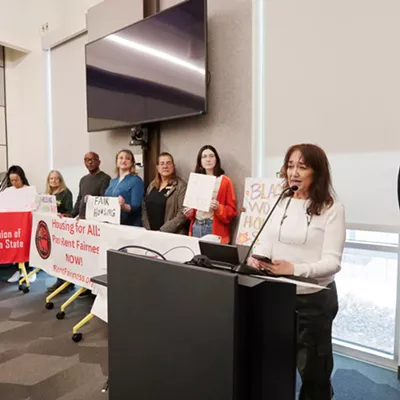In spite of its melodic name, Walla Walla has not often been the inspiration behind works of stunning poetry or arresting art. More likely to be associated with the state penitentiary, onions or god-awful heat, Walla Walla to the uninformed is the refrain to a song you learned in camp, a town with a silly name, one of many small, wheat-skirted Eastern Washington burgs.
That notion fits Walla Walla now about as well as an itchy homespun petticoat. Home to three colleges, at least 17 world class wineries and nearly 50,000 people, Walla Walla has grown into a surprisingly cosmopolitan place that has managed to hang onto its small town charms. A drive of two-and-a-half hours winds into a city that at first doesn't reveal what it has become. But where the downtown corridor once floundered, the street is now lined with trees, cafes, bookstores, galleries and richly turned out little shops.
The Indian word for "many rivers," Walla Walla doesn't have a river running through it like Spokane does, but the drainage canal is so surprisingly picturesque I have to stop to take a picture. Several blocks away, a farmers market dismantles for the day, but the downtown streets are still full of life. Mexican-American grocery stores sit next door to banks, a funky old 1950s-era diner and farther down Main Street, several jaw-droppingly beautiful wine tasting rooms. The sense is that here is a town that has discovered itself and is able to move forward with what it knows.
"It's getting a lot better," says Jayne Eacker, co-owner of Liberty Gallery on Main Street. Her space is not much bigger than the proverbial hole in the wall but feels instead like a mysterious European hideaway. Lanterns, scarves, jewelry and handmade soaps catch the eyes of passersby, while inside art by such notable regional artists as David Wharton and Brad Rude grace the walls. "It's come a long way. I think a lot of it has to do with the wine tasting rooms, with the Walla Walla Foundry and, of course, Whitman College."
Much of the credit for what Walla Walla has become could indeed be laid at the feet of the winemaking renaissance currently underway in the Walla Walla Valley.
"I think the success of the wineries and the success of the arts dovetail one another," says Mark A. Anderson, director and owner of the Walla Walla Foundry. "The kinds of people who are into the wineries are already into the arts and vice versa."
Nowhere is that more evident than in the Cayuse Winery tasting room on Main Street. Painted in the sunny yellows of southern France, the Cayuse is as artful as they come, from its mosaic doorstep to the rich mahogany paneling within. Just around the corner at the Waterbrook Winery tasting room, tourists accept glasses of merlot, cabernet sauvignon and melange from a charming steward with a French accent and a strong desire to keep his temporary class in order. "Too fast. No good to jump," he admonishes when a visitor asks to try a $35 red wine. "There are steps," he adds, pouring and gesturing at the wine list. Sure enough, there are three wines listed between the merlot and the meridian. Again, it's hard to believe this is a windblown town in the southeastern corner of the Palouse.
The feeling of being somewhere infinitely more interesting continues as one walks around town. A big brick building just a few blocks from downtown houses the Carnegie Arts Center, where art classes, lectures and exhibits take place throughout the year. A row of old churches curves around the corner, exhibiting Byzantine, Gothic and Romanesque influences. Nearby is Whitman College, a potent element in the arts renaissance clearly underway.
"If I had to pick one thing [that has made the arts succeed in Walla Walla], it would be the fact that there are three colleges," says Anderson. "Because of that, there's an intellectual base here that sees the value of the arts and supports the arts. I think it also helps that it's an old town, like Spokane, but it's smaller and I think because of that, it's easier to see the arts."
In addition to Whitman, Walla Walla is also home base for Walla Walla Community College and the Seventh Day Adventist school of higher learning, Walla Walla College. While their presence provides an undeniable support for the arts, Whitman College has been instrumental in both bringing a wide variety of visual artists, writers, musicians and other arts people to town and keeping them there.
Anderson and others involved in the arts credit the current president of Whitman College, Tom Cronin. "He's really responsible for starting to collect outdoor sculpture, and he's a big supporter of the Blue Mountain Arts Agency," says Anderson.
The college itself is clearly a place where the arts are just as important as anything else taking place on campus. Recently ranked the top national liberal arts college in the Pacific Northwest in U.S. News & amp; World Report's annual survey, Whitman's athletics program takes a definite backseat to a palpable emphasis on the arts. Signs point toward Whitman College's Sheehan Gallery, where a stunning show of contemporary pottery from the Jewel Creek anagama kiln on the Oregon Coast, a private collection of ancient Korean pottery and a flawlessly realized Japanese tea room are all currently on exhibit. Just outside and across the field is a five-foot tall metal fish balancing on its tail, a lemon and a bowl perched on its pursed lips. Its name is "Three Stories," and it's a piece of public art sculpture from the Walla Walla Foundry by Squire Broel.
Across Boyer Street, one of the college's main avenues, the sign in front of the Fine Art House promises studio art, drama, poetry, coffee, music and air conditioning.
"The air conditioning is actually a huge joke," laughs Chris Haske, an art student at Whitman who serves as the building's resident advisor. It turns out what seemed like an artsy coffee shop from the exterior is a part of Whitman's answer to fraternities and sororities.
"We have a Greek system here, but we also have this campus living option that initially started with the language houses," says Haske. "They're houses where you live with other students that share your interests. So the Fine Art House is dedicated to people interested in art. There's seven of us that live in the Fine Art House, and you have to go through an application and interview process to be selected."
The Fine Art House does host poetry readings and private receptions for visiting artists, while offering studio space to work on projects. And, of course, there's room to show art. "It's kind of a living room-slash-gallery space," says Haske.
Opportunities for arts and culture are frequent and sometimes surprisingly good, Haske says. In addition to the fine arts program, Whitman has a strong creative writing department, which he says "has a great writer's series. This year, Tim O' Brien is coming and then Adrienne Rich in the spring. And a few years ago, they had Seamus Heaney."
No campus worth its accreditation is without a hub, a hang, a place to kick back, and Haske reports that off campus, it's the downtown cafe Merchants. My first stop in Walla Walla, I was already impressed with this place, which offers a French bakery, wine, coffee, cafe fare and a veritable sea of tables, edged with nooks for studying or socializing. A cluster of couches on the cafe's balcony exert their considerable gravitational pull and seem like the perfect place to take in one of the Merchants' frequent live music acts in the evening.
While Haske, who comes to Whitman from Southern California, appreciates Walla Walla's support for the arts, he also sees room for improvement.
"In terms of the kind of art that's already here, the town does okay," says Haske. "But it's pretty limited. There are a few galleries, but they all seem to show the same kind of thing. I do like what they're doing up at the Foundry though; that seems to bring some fresh ideas into town."
The Walla Walla Foundry is indeed an ambitious enterprise, a success story to inspire anyone who would seriously pursue a life in the arts. Founded 20 years ago by Whitman studio art graduate Mark A. Anderson, the four-building, 25,000-square-foot campus is devoted to casting contemporary artwork. Anderson says that his business gained notoriety with the success of two of his former employees, Squire Broel, who exhibited in Spokane last winter at the Lorinda Knight gallery, and Brad Rude, whose paintings will be featured at EWU's art gallery in November.
"They've been selling a lot of their work, both two- and three-dimensional," says Anderson.
Anderson, who has lived in Walla Walla his entire life, is impressed with what the town has become. He talks about the Whitman Tower, the town's tallest building, which is currently surrounded by scaffolding in the midst of its renovation. "When that gets finished, it's going to be incredible," says Anderson. "It has a ballroom and some really beautiful spaces." For Anderson and others who have watched the city transform, it's an exciting time.
"One of the things I've really enjoyed seeing is the 1950 aluminum facades come off the buildings," Anderson remarks. "A lot of that I would have to say is the doing of the downtown Walla Walla Downtown Foundation. There are people who understand the value of downtown and have worked really hard to preserve it."
It makes one wonder how a town the size of Walla Walla can pull it off. The answer could be found in having just enough like-minded people in one place to make a difference.
"We had an event last June at the foundry for the Blue Mountain Arts Agency, it was outdoors, there was live music, it was really something. I came away from it feeling that we do have such a strong arts community," says Anderson. "We'd had an event the day before called Artwalla, which was just artists. So there were two major art happenings in one weekend. We tried to invite a broad spectrum -- visual artists, musicians, writers, sculptors. We had 200 people and it was still only a fraction of everyone we could have invited. And the best thing is how many people came up to me to tell me how nice it was to come to an event just to be acknowledged for being an artist."
















